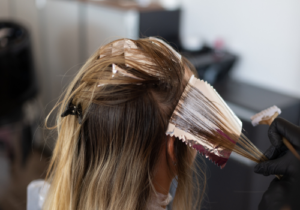Introduction to hair color and the root effect
Hair coloring is a popular way to change your look, express your personality, or cover gray hair. However, one of the challenges of hair coloring is the root effect, which occurs when the hair's natural roots begin to appear, contrasting with the dyed color. Understanding this phenomenon is crucial for anyone wishing to have evenly and aesthetically colored hair without the unsightly root effect.
What is hair coloring?
Hair coloring involves the application of a specific dye to the hair to change its natural color. This chemical process can be used for a variety of purposes, such as enhancing natural color, covering gray or white hair, or adopting a new shade for a radical change in appearance. Hair color products vary considerably in terms of durability, from temporary options to permanent solutions.
Definition and overview of the root effect
Root effect occurs when new hair grows in, exposing the contrast between your dye color and your natural hair color. More noticeable in people with permanent hair color, root effect can detract from the well-groomed appearance of perfectly tinted hair. Maintaining even color requires special care and regular maintenance.
Why does the root effect occur?
The root effect is the inevitable result of hair growth after coloring. As hair grows, the natural color of the roots becomes visible and often contrasts with the applied tint. How quickly this happens depends on a number of factors, including the speed of hair growth, the contrast between the natural color and the tint, and the quality of the color used.

Methods to avoid the root effect during coloring
Choose the right hair color
A judicious choice of hair color can make all the difference in avoiding the root effect. By selecting a shade that blends well with your natural color, you minimize the contrast when your roots start to show. This allows you to extend the time between touch-ups.
How do you choose the right color for your hair?
To choose the right color, take into account your natural skin tone and complexion. Opt for a color two to three shades lighter or darker than your natural color for a softer effect. Ashy colors are particularly effective at masking gray roots, while warm tones are better suited to darker skin tones. Consult a colorist for personalized, professional advice.
Regular maintenance and root touch-up
Regular maintenance is essential to maintain even color and avoid the root effect. Plan regular touch-ups to prevent your natural roots from becoming too visible. This keeps your hair color looking neat and professional.
How and when to dye hair roots?
Retouching your roots every four to six weeks is generally recommended, although this can vary depending on your rate of regrowth and the color you choose. Retouching involves applying dye only to the roots to refresh the color while avoiding overloading the rest of the hair with chemicals. Use the right care products after each touch-up to preserve the health and beauty of your color-treated hair.
Special coloring techniques
There are several coloring techniques that can help minimize the root effect by creating a natural gradient or mixing similar shades that blend with your hair as it grows.
Introduction to the scanning method
Balayage is a coloring method that involves freehand painting highlights onto hair for a more natural, less structured effect. This technique allows for less obvious root growth, as the shades are integrated in such a way as to blur the line of demarcation. Balayage creates a sun-kissed, multi-dimensional effect that is particularly effective in avoiding sharp root contrast. It's a popular choice for those looking to reduce the frequency of touch-ups.
By following these tips and methods, you can maintain harmonious color, reduce the appearance of root effects and extend the time between visits to the hairdresser. Careful maintenance guarantees long-lasting aesthetic and elegant results.
See also: How to add volume with a hair wax?
Temporary coloring techniques to hide the root effect
Use of root color retouching products
For those who want to hide the root effect without resorting to permanent coloring, using temporary touch-up products is an effective solution. These products are designed to blend with your existing hair color, camouflaging visible roots until your next coloring session.
Types of root retouching products
- Colored sprays: Easy to use, they enable fast, targeted application to the roots. They come in a variety of shades, making it easy to match your current color. Color usually fades after one or two washes.
- Coloured powders: They can be applied with a brush or sponge, and offer immediate coverage. Ideal for occasional touch-ups, they are often water-resistant, ensuring all-day wear.
- Mascaras for hair : Similar to lash mascaras, these products are ideal for precise application to roots and stubborn strands. Although temporary, their effect generally lasts until the next shampoo.
Tips on maintaining and moisturizing dyed hair
Maintaining dyed hair isn't just about color - it's crucial to keep it healthy too. Good care not only guarantees vibrant color, but also strong, shiny hair.
Recommended moisturizing routines for dyed hair
- Choose shampoos and conditioners formulated for color-treated hair: These products help preserve color intensity while providing chemically-treated hair with the nutrients it needs.
- Incorporate a weekly nourishing hair mask: Dyed hair can be dry and brittle, so regular deep moisturizing is essential. Opt for masks rich in natural oils such as argan or coconut oil.
- Avoid excessive use of heating devices: Heat can aggravate dryness in dyed hair and accelerate fading. Use heat protection products and moderate the temperature of heating tools.
- Think hair oils: After each wash, apply a few drops of oil to seal in moisture. Jojoba and camellia oils are renowned for nourishing hair without weighing it down.
Finally, while root cover is a practical short-term solution, nothing beats regular maintenance and quality care to preserve not only the color but also the overall health of your hair. By incorporating these techniques and products into your hair routine, you can manage the root effect effectively while keeping your hair glowing with health and vitality.
Potential problems and solutions when avoiding the root effect
Impact of chemicals on hair
Understanding the effects of hair dyes
Hair dyes often contain harsh chemicals that can not only alter hair color, but also affect overall health. Ammonia and hydrogen peroxide, for example, can damage the hair cuticle, making it dry and brittle. It's therefore crucial to choose less aggressive products and adopt appropriate hair care products to minimize this damage.
Sensitivities and allergies
How to prevent and manage adverse reactions
Before applying a new tincture, it's important to perform an allergy test on a small area of skin, usually behind the ear, to ensure that there is no allergic reaction. If you notice any redness, itching or inflammation, it is advisable not to use the product and to consult a professional for hypoallergenic alternatives.
Unexpected color problems
How to correct unsatisfactory color?
Occasionally, the resulting color doesn't match our expectations. In such cases, there are several solutions, including the use of clarifying shampoos to fade the color, or consulting a colorist to adjust the shade. Avoid rectifying on your own with non-professional products, as this could make the situation worse.
Hair wash management
Strategies for extending color life
How often and how well you wash your color-treated hair has a significant impact on the longevity of the color. Preferably use shampoos for colored hair and avoid very hot water, which can open the hair cuticle, resulting in faster fading. For extra protection, incorporate a leave-in conditioner that seals the cuticle.
FAQ
How can you prevent roots from appearing too quickly?
Choosing a color close to your natural skin tone can help reduce the rapid appearance of roots. What's more, techniques like balayage create a more blended effect.
How long do root touch-up products last?
Temporary touch-up products, such as sprays and powders, generally last until your next shampoo.
How to repair hair damaged by dyeing?
Regular nourishing treatments with deep masks and natural oils can help restore hair vitality.
Is it possible to dye your hair without chemicals?
Yes, vegetable dyes like henna offer a natural alternative to chemical dyes, although the results may be less intense.
What's the most effective way to keep dyed hair moisturized?
Regular use of moisturizing masks and natural oils, as well as gentle washing, is recommended to retain moisture.
By adopting these tips, you can not only prevent the root effect, but also maintain the health and beauty of your color-treated hair. Take care of your hair to keep it healthy and shiny


